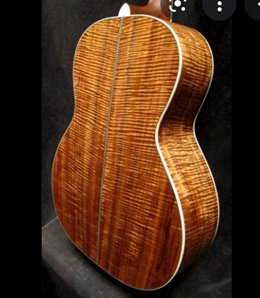AgEBB-MU CAFNR Extension
Green Horizons
Spring 2022
Chatoyance In Wood
Lynn Barnickol, Missouri Consulting Foresters Association
Cat's eyes have a complex structure that makes them seem as though they are glowing in the dark. In fact, cat's eyes are often compared to the intense, three-dimensional luster of jewels. In the world of woodworking, there's a lesser known analogy to cat's eyes. It's called "chatoyance," often referred to as "cat's eye effect," a term that describes the way light dances off the grain of the wood. In French, the word for "cat" is "chat," and this is partly from where the word "chatoyance" derives its meaning.
Most are familiar with grain in wood as being straight, cross-grained, or crooked. Figure is where wood gets interesting from a woodworker's point of view. Chatoyance is an appearance that gives a lustrous, three-dimensional effect to the figure in wood that is described as cat-eye. This is not to be confused with birds-eye in sugar maple. Rather, chatoyance describes the depth of reflected light in the figure of some pieces of wood.
Figure and chatoyance are thought to be formed in the tree by stress. However, the process is a bit mysterious. Too much stress in a tree can cause bends and twists that could lead to defective wood, such as growth ring separation or wind-shake. Stress associated with crotches or forks and branches can cause the wood cells to form a ripple effect by doubling back on themselves. The cells being uniquely configured provide an appearance that is often described as cathedral, flame, quilted, fiddle-back, burl, birds-eye, or spalted.
Figure and the sub-set of chatoyance are important elements to woodworking because each adds interest to wood. Northern and southern wood grain can refer to how rapid the tree is growing. In hardwood, grading rules dictate typically straight-grained wood used in furniture. This is for good reason, as straight grained wood is uniform and less likely to warp in a finished piece of furniture. Figure in wood adds interest but can be unpredictable as it dries. Still, there is great interest in the non-uniform figure due to how it catches and reflects light.
 |
| Example of fiddle-back wood in an acoustic guitar. |
Custom woodworkers, wood turners, and artisans are more likely to be interested in chatoyance and other figure in wood because of the interesting patterns, colors, and textures. Custom work and unique wood can be fairly valuable, especially compared to big-box stores that likely sell their solid wood furniture made of straight-grained wood.
While the word is too long to show up in the recently popular game Worldle (where the limit is five letters), it's a great one to keep in your back pocket for Scrabble, Words with Friends, and intense crossword puzzles. Besides that, chatoyance always catches your eye in a sentence-as well as when its present in a finished piece of woodworking. The next time you visit your local woodworker, look for the way the wood reflects light and celebrate when you locate a chatoyant piece reminiscent of a cat's eye glowing quietly in the dark.
Google Sources: Mariam-Webster Dictionary, Woodworkers Guild of America, and Reddit Images
